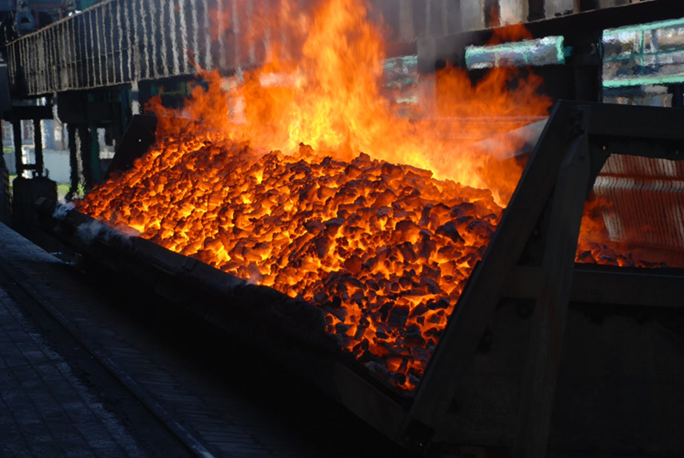Coal Basics
What Is Coal?
Coal is a solid hydrocarbon formed from plants in the geological past and preserved by burial under various sedimentary rocks. The preservation process begins with the breakdown of the plant material by the actions of bacteria and fungi followed by progressively deeper burial that initially squeezes out water and ultimately drives out gases such as CO2 and CH4 as ground temperatures rise. Coal is a mixture of organic matter, mineral matter (clays and quartz mostly) and water. Only the organic matter contains the energy of the coal, the mineral matter contains no energy and the water normally requires energy to vapourise it. The organic matter is composed of both volatile matter (gases and oils) that is given off on heating the coal, the other organic component of coal is called fixed carbon. The ratio of fixed carbon to volatile matter increases as the depth of burial increases and this is described as an increase in coal rank.

Steeply dipping coal seams at the Adaro Opencut mine in Kalimantan Indonesia
Coal Rank
The rank of a coal is used to identify its position on the continuum that starts with peat, progresses through brown coal then lignite, followed by sub-bituminous coal, through bituminous coal and finally to anthracite. The progression is shown below (Table 1).
| Rank | Moisture (ar) | Energy (ar) | Volatile Matter (daf)* | Fixed carbon (daf)* | Comments |
| Peat | >55 – 70% | ~10 MJ/kg | ~70% | 30% | Buried to ~ 100m |
| Brown Coal | 45 – 55% | 10 – 13 MJ/kg | 68% | 32% | Buried to ~800m |
| Lignite | 30 – 45% | 13 – 20 MJ/kg | 65% | 35% | Buried to ~ 1,200m |
| Sub-bituminous coal | 15 – 30% | 20 – 25 MJ/kg | 45% | 55% | Buried to ~ 2,400m, black, cracks in the sun. |
| Bituminous coal | 8 – 15% | 25 – 35 MJ/kg | 25% | 75% | Buried to ~ 4,500 m, black and shiny. Heated to ~160°C |
| Anthracite | 6 – 8% | ~35 MJ/kg | 3% | 97% | Buried up to 10 km, very shiny and can be hard. Heated to >200°C. |
* dry ash free
Uses for Coal
Coal is normally used for its energy content in thermal applications or it is used for the development of plastic properties and carbon content when used as a coking or metallurgical coal.

Huntly thermal power station running on coal located at Huntly, south of Auckland New Zealand
Thermal Coal
Thermal coals are mostly used for generation of electricity via steam turbines, or for the calcination of limestone for the manufacture of cement. Alternatively coal can be used for the raising of heat in institutions such as hospitals, schools and meatworks or for industrial processes such as those used by the dairy industry in the production of milk powder.
The advantage of coal over nearly all other sources of energy are:
- It is cheap in terms of US$/GJ
- It is plentiful and found in most countries
- It is easy to store and to transport
Power is the rate of energy consumption, normally expressed in Watts. One Watt is the expenditure of 1 joule of energy for 1 second. A kiloWatt of power is 1,000 Joules of energy expended over 1 second. Power stations are normally rated at the maximum amount of electrical power that can be produced. A large modern coal fired power station can convert coal energy to electrical energy at about 45% efficiency. If it is rated at 1,000 MegaWatts it will produce 1,000 Megawatts and at 45% efficiency it will burn 2,222 MJ/second. The coal the Huntly Power Station consumes is rated at 22.22 MJ/kg and the power station consumes 100 kgs of coal per second or 360,000 kgs per hour. If it operated 24 hours per day and 7 days per week the power station would consume 3,153,600 tonnes per annum.

Metallurgical coke freshly pushed from a coke oven at a coke works in Ostrava, Czech Republic.
Metallurgical Coal
Coal has been used for the reduction of metallic oxide ores for many centuries. It is the carbon in the coal that is used to reduce (remove the oxygen from the metal oxide) the metallic oxide to a metal with the commensurate release of carbon dioxide gas. The carbon in the coal is obtained by heating the coal in the absence of air, this heating process drives off the volatile matter (gases and liquids) leaving behind a carbon rich coke or char.
This coke or char is combined with the metallic oxide in a furnace at very high temperatures to produce a liquid metal in the following type of reaction:-
Carbon (coke or char) + Metallic Oxide → Metal (liquid) + CO2 (gas) + a molten Slag
In most processes the carbon is converted to coke which is a hard, porous and unreactive form of carbon. This process uses coking coals to make the coke which is used in a vertical furnace where coke strength is important. This process produces a molten metal that is tapped off in a liquid state for further processing. Where a char is produced, processing of the metallic oxide is normally achieved in a rotary kiln in what is referred to as a direct reduction process. The direct reduction process produces a metal that forms a sponge that must be melted in an electric melting furnace.
The molten liquid produced in either process is much more dense than the slag and the slag (which contains all the ash from the metallic oxide and the coke/char) floats on top of the molten metal.
The slag can be used as an additive to cement as it normally has pozzolanic (cementitious) properties.
